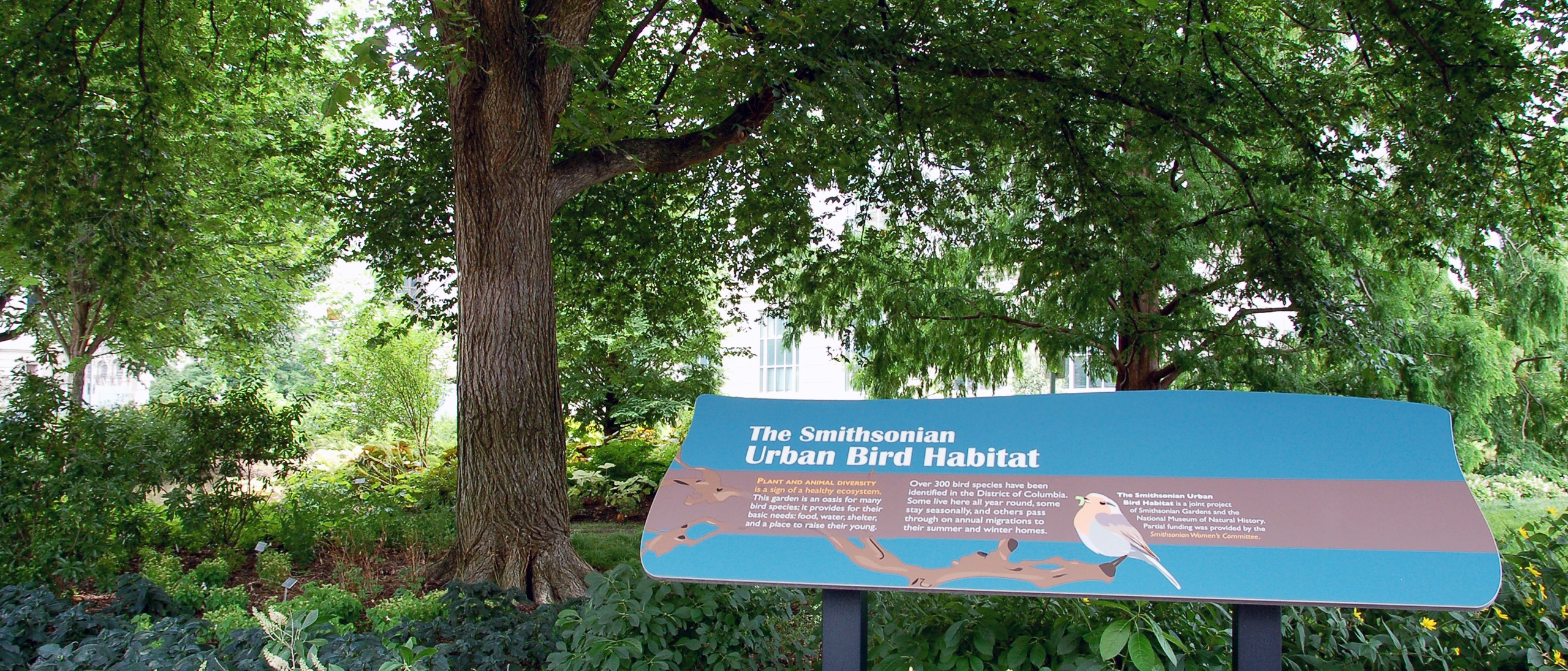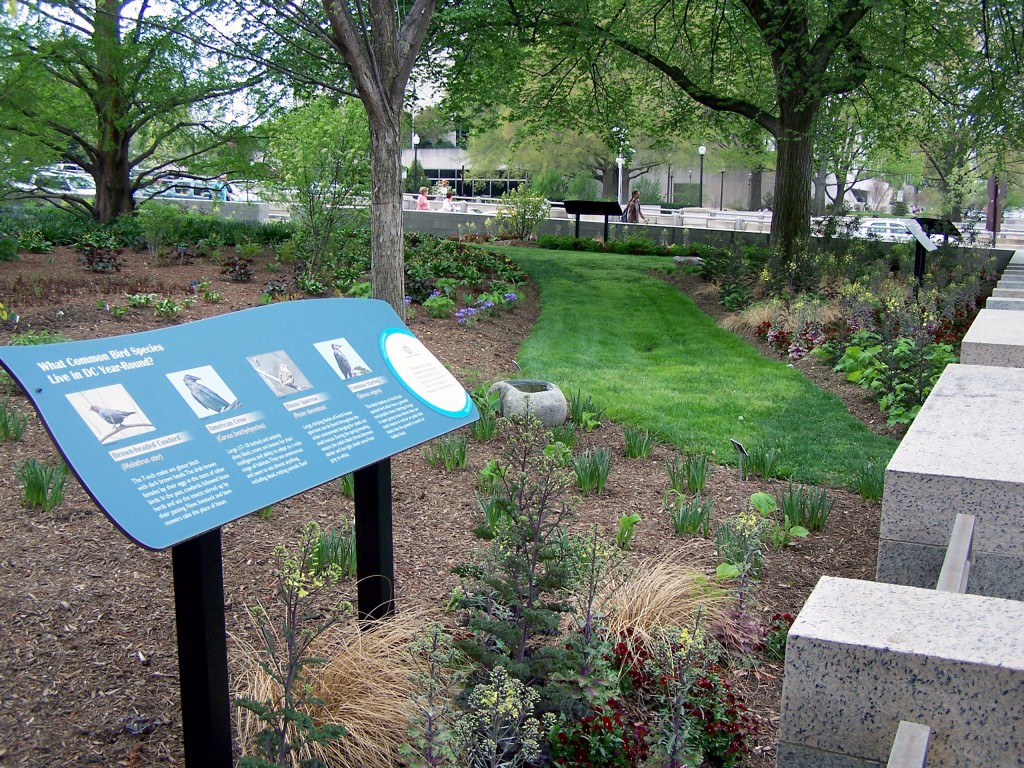
Urban Bird Habitat at the National Museum of Natural History
A bird oasis in the heart of the Nation’s Capital.
Click here to view the Tree Collection and Display Collection inventories for this garden.
The Urban Bird Habitat wraps around the south, west, and north sides of the Smithsonian National Museum of Natural History and furnishes an oasis for many bird species. The garden plantings and hardscape elements provide birds with food, water, shelter, and a place to raise their young.
Plant and animal diversity is a sign of a healthy ecosystem. Over 300 bird species have been identified in the District of Columbia. Some live here all year round, some stay for a season or two, and others pass through on their annual migrations to their summer and winter homes. By providing for the basic habitat needs of these birds, Smithsonian Gardens hopes to preserve and promote bird diversity in the heart of the Nation’s Capital.
The Smithsonian Urban Bird Habitat is a joint project of Smithsonian Gardens and the National Museum of Natural History. Partial funding was provided by a grant from the Smithsonian Women’s Committee.
What can you provide to encourage birds to visit your backyard?
All birds need three basic things from their habitat: food, water, and shelter.
Food: Birds eat the fruit, seeds, and nectar from a variety of plants. They also eat insects and other small animals that thrive in a healthy ecosystem.
Water: Birds drink fresh water wherever it collects—from rain or sprinklers, even leaking water fountains. They can also get moisture from eating berries.
Shelter: Plants provide birds with safe places to sleep, hide from predators, and raise their young. Plants also give shade from the heat, warmth from winter’s snows, and a dry place when it rains.
But what do the plants get out of it?
Plants don’t get around much. They need help from the natural elements and other animals to reproduce. Some bird species help plants by carrying pollen from one flower to another.
Seeds that sprout farther away from the parent plant may have a better chance of surviving. Plants must rely on the wind, gravity, water, and animals to spread their seeds. Many birds eat the fruit and seeds of shrubs and trees then disperse them after they fly away.
What’s happening in the urban bird habitat?
Birds behave in different ways depending on the time of year. You can help birds find sanctuary in your home garden by planting and pruning with their needs in mind.
Spring: Birds are building their nests to raise their young. Leaving small piles of plant stems, twigs, and vines from winter and early spring pruning provides birds with plenty of construction material.
Summer: Birds are seeking relief from summer heat and pests. Filling small depressions in rocks with water gives birds something to drink to cool down. Leaving patches of bare ground provides a place for birds to take “dust baths” to get rid of pesky parasites.
Autumn: Birds are eating high fat seeds and fruits to build up reserves for migration and winter survival. Leaving seed heads on plants will provide the food that will fatten up the birds for the winter.
Winter: Birds are searching for shelter from the cold. Evergreen trees and shrubs in the garden provide birds protection from the harsh winter weather.
What types of plants best attract birds to the garden?
Local and migratory birds have evolved to depend on native plants for food and shelter.
Some local birds eat many berries, seeds, or insects. But some have a very restricted diet, and only eat from specific native plants. Not all non-native plants—those planted outside their natural range—are bad for birds. However, invasive plants, like Japanese barberry (Berberis thunbergii) and English ivy (Hedera helix), are bullies, crowding out the native plants that some birds need to thrive.
A diverse, healthy ecosystem containing native plants best meets the needs of wild birds. You can replace ornamental invasive plant species in your garden with native plants with beautiful flowers and delicious berries for birds. Check with your local cooperative extension office or plant society for recommendations of plants that are appropriate for your area.

What common bird species live in DC year round?
Brown-headed Cowbird (Molothrus ater)
Female cowbirds lay their eggs in the nests of other birds. Cowbirds followed bison herds and ate the insects stirred up by their passing. Lawn mowers now take the place of bison. The 7-inch males are glossy black with dark brown heads.
American Crow (Corvus brachyrhynchos)
Large (17-18 inches) and entirely shiny black, crows are known for their intelligence and ability to adapt to a wide range of habitats. They are omnivorous and seem to eat almost anything, including carrion .
House Sparrow (Passer domesticus)
Large, chirping flocks of the 6-inch house sparrows can be found throughout the urban environment foraging for seeds and small insects. During the spring breeding season, the male’s black throat becomes darker and the light cheek turns from gray to white.
Common Starling (Sturnus vulgaris)
The black feathers of this 8-inch spotted bird often have a greenish and purplish sheen. Starlings forage in open grassy areas where they can catch insects in mid-air or pry their beaks into the ground in search for hidden food.







